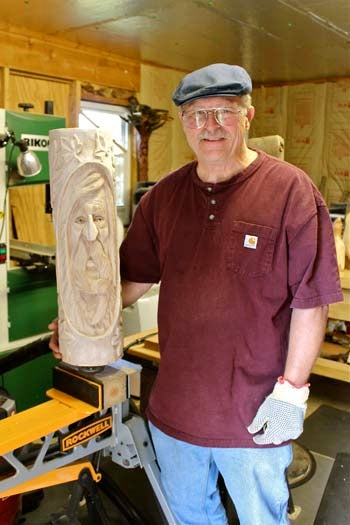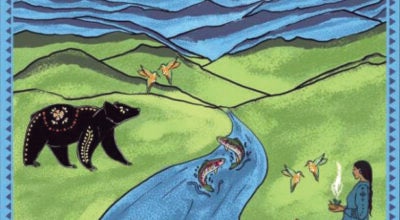Spirits in the Woods: Carving faces for public spaces
Published 10:00 pm Friday, October 17, 2014
 Cultures the world over and through the centuries have believed in the spirits that inhabit trees. Roman and Greek mythology, legends from the Dark Ages, Native American tales, Japanese stories, Thai folklore, ancient mythical Sanskrit, and many more traditions hold that tree spirits are deities, guides, protectors, healers, nymphs or benevolent ancient souls. European villagers believed that only the pure of heart could see tree spirits. They were to be honored, decorated, respected, and in some cases, given a human face.
Cultures the world over and through the centuries have believed in the spirits that inhabit trees. Roman and Greek mythology, legends from the Dark Ages, Native American tales, Japanese stories, Thai folklore, ancient mythical Sanskrit, and many more traditions hold that tree spirits are deities, guides, protectors, healers, nymphs or benevolent ancient souls. European villagers believed that only the pure of heart could see tree spirits. They were to be honored, decorated, respected, and in some cases, given a human face.
Don Blackwell has the gift that allows him to “see” spirit faces in twisted tree trunks, discarded logs, in cypress knots and in walking sticks, and carve out intricately detailed interpretations of tree spirits. With scraggly beards, overhanging eyebrows, and an abundance of wrinkles — minute etchings juxtaposed with deep ridges — Blackwell evinces these wise watching souls from the tree’s core, grain and bark.
Blackwell’s home, studio and woodshop in East Flat Rock contain a busy collection of wooden spirit faces in various stages of completion standing guard over the home, as well as boxes of branches, twisted trunks and sticks waiting for him to carve personalities from their curves. With names like Pitkin, Murphy, Morpheus, Milo, Simon, Jean-Claude, Mordecai and Shamus, they are as different as the wood from which they are carved, each with their own individual story.
Although he has been an artist since the age of five, the soft-spoken Blackwell took up carving just eight years ago. Tennessean wood carver, Billy Reynolds, was an inspiration to Blackwell as he was teaching himself the craft. His wife of 20 years, Phoebe, a children’s book illustrator, is his “muse.” He used to buy Band-Aids by the case when he first began, but has perfected his craft through the years and now teaches woodcarving at the Columbus branch of Isothermal Community College in a class titled, Mountain Heritage.
“The Mountain Heritage class gives people the opportunity to learn something that will augment their income,” said Blackwell. “Every one of my students who wants to sell their work is doing so,” he added.
The emphasis on teaching artists to consider and use their craft as an engine of economic development is an initiative championed by the HandMade in America organization, which last year named Columbus to its list of partner towns. Using National Endowment for the Arts Our Town funding, together with partnerships with a variety of community foundations, arts commissions, heritage preservation groups, and regional economic development organizations, Asheville-based HandMade in America will provide the “Discover Columbus” steering committee advice and guidance in developing and promoting Columbus’ creative economy.
One of the first projects recommended by the steering committee was the placement of public art in high-visibility areas. Committee member Ernie Kan approached Blackwell and two other woodcarvers, Albert Oldham and Art Sauder, with the idea. On August 21, the three carvers unveiled their creations at Columbus Town Council meeting. Their carvings will go on display at the Welcome Center on I-26, Columbus Town Hall and the Columbus Branch of Isothermal Community College.
According to Blackwell, Mill on Wheels, owned by Green Creek residents Chris and Amy Carroll, donated the 12 foot long red cedar tree for the three carvers to use. They divided it into three pieces; Blackwell’s portion was the trunk and roots. The final piece came to be named Mordecai.
While his focus in recent years has been woodcarving, Blackwell, a Hendersonville native, is an accomplished artist in several media. For most of his 23-year Air Force and Alaska Air National Guard career, he was a graphic artist assigned to various bases in Alaska. His murals, prints and illustrations grace programs, books, museums, and walls in a number of states across the country and internationally.
His works are made with pen and ink, watercolor, airbrush, oil and colored pencil. He also uses a technique he calls pyrography, or the cutting and burning of images into leather. The influence of Alaska — from its independent, pioneering people, to the close-knit military culture, to the abundant wildlife – permeates all of the art lining the walls of his home.
One project that he found particularly gratifying, yet haunting, was one in which he drew portraits of the homeless in Anchorage. He paid each person $20 to sit for a photo portrait, for the Faces of Homelessness series. He then used the photo to create pointillist drawings that captured the essence of their homeless story. They went on display in a local gallery, and then were auctioned to raise money for the soup kitchen that kept these men and women, several of whom were military veterans, fed and sheltered.
“It’s so gratifying to be able to give back,” said Blackwell. “With art, we’re doing something that helps people. Your talent is a gift from God. What you do with it is your gift back.”
Blackwell said that everyone is born with ability in art, “but our society is geared to the left side of the brain, with logic and strait lines.” In nature, he said, “there are no strait lines, there are curves.” Referring to art in schools, Blackwell said that art is just as important as math or science.
“The intimacy of art is what allows people to plug into their universe,” said Blackwell. “With art, we’re doing something that helps people. With art, people share at a spiritual level something that transcends everyday life.”
PHOTO: Working at his kitchen table with fine carving instruments, or in his workshop adjacent to his home in East Flat Rock, Blackwell uses black gum, sweet gum, cedar, cypress, and cottonwood for his wood spirit carvings. The wood comes to him from as close as Green Creek, to as far away as Louisiana’s swamps and Canada’s wild forests.





